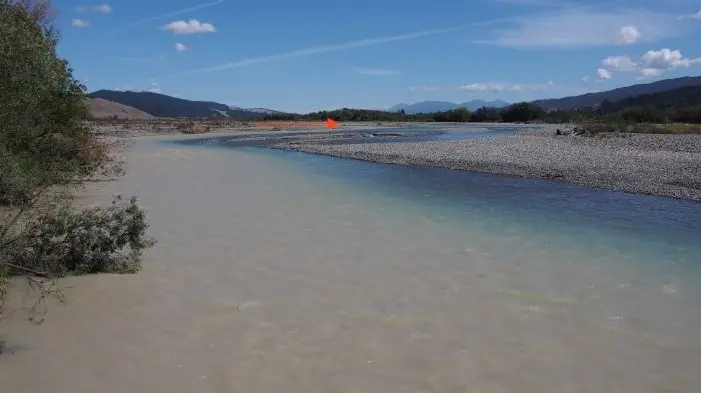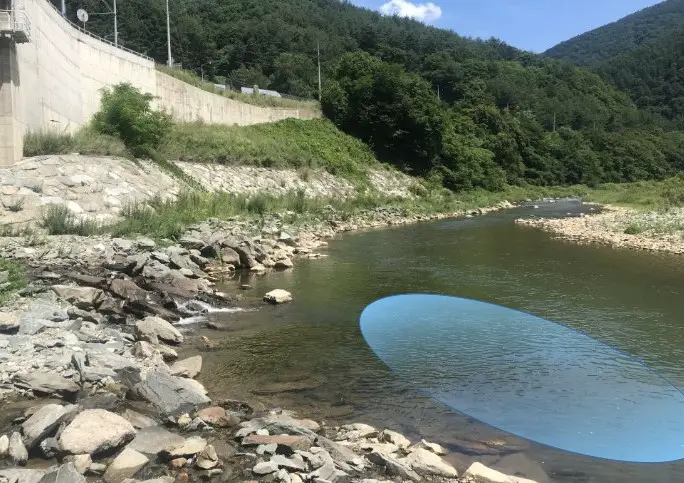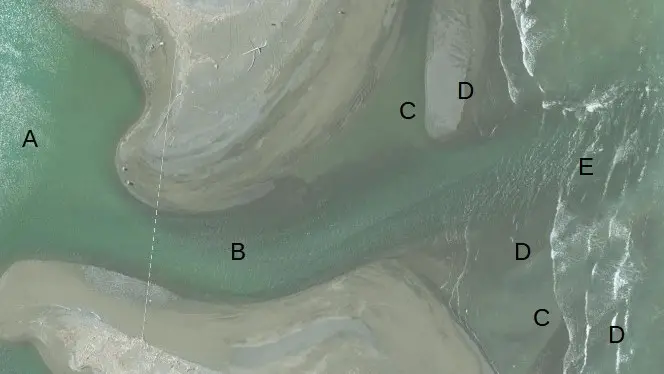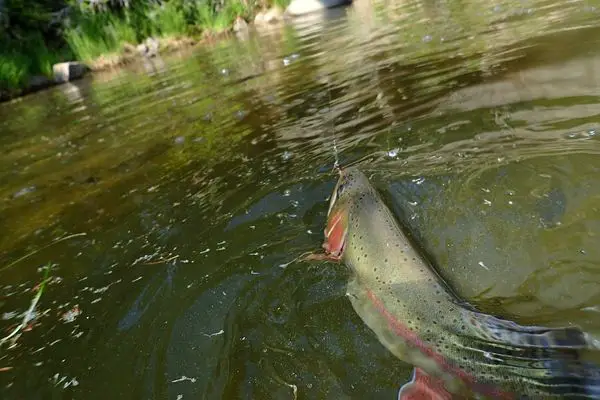River mouths are often the site where trout gather in large numbers. There are four main reasons why trout gather there.
- Abundant Food Supply: River mouths provide a nutrient-rich environment due to the flow of rivers carrying sediments and aquatic organisms. This leads to a diverse food chain, including small baitfish, insects, and crustaceans, which attract trout in large numbers.
- Oxygen and Temperature Conditions: River mouths often have increased oxygen levels and slightly different temperatures compared to the main river or larger body of water. This means in warm water conditions trout often find refuge at the mouths of cooler streams.
- Waiting for Spawning Migration: Trout may gather at river mouths while waiting for favorable conditions for their upstream spawning migration. They use these areas as staging points to conserve energy, exhibiting increased aggression and territorial behavior until conditions such as water levels and temperatures become suitable for their upstream journey.
- Transition Zone: River mouths serve as crucial transition zones between freshwater and saltwater environments. They facilitate the movement of trout, especially sea-run, between these two habitats for spawning or feeding.
At river mouths, when the fishing is tough, I believe the old adage that 10% of fishermen catch 90% of the fish holds true.
Sometimes different tactics can bring very different results. After work, in the evenings I used to fish my local river mouth frequently, and it was common to see nobody catching, but within minutes I will be onto a fish. The reason why is quite simple, most of fishermen were spin anglers casting large chunks of metal that the trout will ignore unless they were in a rather aggressive mood, simply changing to a wiggly streamer, or a more lifelike small jerkbait was often enough convince trout to bite.
I have also seen the opposite, when the fly fishermen are casting skillfully, but catching nothing. But people using spinning gear are hooking up. This normally happens when the trout are holding further than the fly fishermen can cast. Every day is different, so it pays to keep a close eye on what is happening and adapt accordingly.
For this reason, I always bring along a spinning rod and a fly rod. I like to be able to cover all bases. A spinning rod is also useful when there is an onshore breeze.
When is the best time to target trout at river mouths?
River mouths can be fished at any time really but are certainly more productive at specific times of year, and day.
Best time of year to fish river mouths
1) One of the best times to target river mouths is as spawning approaches. The exact dates are location and temperature-dependent. As the spawn approaches, trout will start to gather at the entrance of their spawning springs, usually waiting until rain raises the water level allowing them to swim further upstream. Check here for an indication of when trout spawn.
2) Summer, when the water temperature of the main river exceeds 68F is an excellent time to target trout at river mouths. They move downstream of cold water tributaries to take advantage of the lower temperatures.
3) Finally, trout often gather at river mouths when there is an abundance of food there. The food could be entering the river or getting washed down. For example, if migratory baitfish are schooling, and getting ready to spawn, chances are the trout will be nearby waiting to ambush them. Also, after heavy rain, trout often gather to feed upon any drowned worms and dislodged insects.
Best time of day to fish river mouths
At coastal river mouths. Either at the sea or large lakes. First light, just as the rays breach the horizon is often the best time of day to fish river mouths, that is because trout often move close to shore during the night. As the day brightens, they move further offshore seeking shade in deeper water as the light becomes more intense.
In freshwater lakes, the best fishing is often at night. This is when the trout more confidently approach the shallows. Maybe to chase prey, or just to scout ahead searching for upstream passage.
How to tell if a river mouth is worth fishing?
I consider all water to be worth fishing, but some mouths are simply too enormous or too small to be worth the effort.
Some river mouths are enormous, over a mile wide, and surrounded by hundreds of acres of deltas. There is usually good fishing in and among the channels, but identifying the river mouth itself is certainly a challenge. Plus, there is nothing really to stop the trout from moving upstream so they are unlikely to hold in any one place for long.
I prefer to fish the mouths of small to medium size rivers. Where there is a noticeable difference between the ‘river mouth’ and the body of water it is flowing into. It needs to be large enough to support trout, but shallow enough to impede their upstream movement during dry conditions.
If there is some sort of natural barrier, it encourages the trout to slow down their migration and hang around. In some cases, they might wait several weeks for rain, other times they might just group up during the day before running upstream under the cover of darkness.
There does not need to be a flowing connection for trout to gather, I have caught trout fishing off blind rivers where a gravel bar has blocked access to the spawning stream. The waiting trout can smell the scent of the water as it seeps through the stones.
How to know when a river mouth is producing?
The best way to find out is by fishing it, or by asking around local anglers. If an area is fishing well the news normally spread quickly.
When it is a popular spot, the backup option is to observe other anglers fishing there. If you pull into the parking and see lines of anglers battling fish then it is a very good sign that the fishing is hot.
On the other hand, if everyone is standing around, chatting rather than fishing. This suggests there is not much happening at that time.
Fishing from shore vs from a boat
It is often possible to fish river mouths from the shore or from a moored boat.
The main advantage, of fishing from a moored boat, is the ability to fish right over the top of where the trout are holding. Personally, if I have an area to myself I like to troll, in a lazy zig-zag pattern, this allows me to cover a lot of water and find where the trout are holding.
Shore anglers, have to wait for the trout to move within casting distance of the shore. Generally speaking, the larger the river, the more useful a boat becomes.
Many river mouths are now trapped between boulder jetties and breakwaters, this forces all of the current to flow straight out to sea. This makes the mouth deeper, and faster than it will naturally be causing the fish to pass upstream quickly.
Trout fishing a stream entering a river

I wanted to use the above photo as an example because it demonstrates well how long it takes tributary water to merge and mix with the main flow. The red arrow in the distance marks the river’s mouth.
Even a small tributary can influence a river for hundreds of feet downstream. Now instead of clean and dirty water, imagine it is warm and cold water mixing together.

- Warm water floats on top of colder water, so the further downstream you go the deeper the tributary water will become. It also means deeper presentations usually work better than top water.
- It might seem obvious, that the tributary has the greatest influence on the side of the river it enters from. Concentrate your fishing there.
- When migrating, trout will gather in the first deep hole downstream of the tributary. This might be right at the mouth, but if the mouth joins a shallow section the trout will group together further downstream in the first appropriate pool.
- The majority of the migrating trout will be laying close to or on the bottom. They are trying to conserve energy, and stay out of the current. So presentations close to the river floor offer the best likelihood of hooking one. They are not normally hungry, so will not move far to intercept a wayward lure or fly.
Fishing for trout at coastal river mouths

Few trout anglers get to fish for trout at sea, simply because they live too far inland. Other times, coastal and warmer water species dominate the lower rivers restricting trout to further upstream.
- The most productive time to fish a river mouth is first light.
- The biggest difference between a coastal river mouth and a lake is the tides.
- Avoid fishing in very rough conditions.
The gut and lagoon
The gut is the constantly changing channel that drains the river or estuary. It is normally very swift with plenty of current.
- Generally fishes best top half of the incoming tide.
- Nowadays, Often trapped between man-made breakwaters or jetties.
- Due to the speed of the flow, fish rarely linger in the gut. They cling to the river floor while powering upstream. Best to fish hard against the bottom.
- In extremely fast flows, the slack water at the top of the gut is often productive. It seems that the trout will stop to rest for a while after battling against the current.
Spot A marks the lagoon, estuary, or lower river. The water there is generally slow flowing and migrating trout have very little reason to stick around. At night, sometimes it is possible to find trout hunting baitfish in the shallows.
Spot B is the Gut or river channel itself, notice how it is not of uniform depth. Trout often speed up tight to the bottom in the deepest part of the gut.
The surf and sea
- Steelhead and sea run trout often congregate there when river levels are either extremely low or extremely high.
- When flows are low, there is not enough water to encourage them to migrate upstream so they just wait it out.
- When flows are extremely high, there is too much current and they wait for it to slacken before pushing upstream.
- Fish generally hold higher in the water column, fish off the bottom,
- Fishing is generally best around low tide, although that does depend on water depth.
– Spot C mark slightly deeper water (holes, channels) off the mouth, over high tide the trout might choose to wait there ambushing baitfish disoriented by the surf. The deeper water can usually be identified by calmer water.
–Spots D marks gravel bar, the water is very shallow and fish rarely if ever hold there. In some rivers, the bars are made out of soft sand/mud and not gravel. At low tide, like in the photo, sometimes it is possible to walk far out to sea on the bars allowing casting into deeper water.
– Spot E is where the force of the river and sea cancel each other out. Trout often wait just off there for conditions to improve. They can also sit there feeding on any morsels getting washed downstream.
River mouth trout fishing in lakes
Lakes differ from seas in two main ways, the tides are minuscule and can be ignored, and there is no ocean swells to worry about.
Migrating fish
- Without tides to complicate factors, migrating trout are a lot more predictable in lakes. Their movement, once water temperatures are suitable will likely be dedicated by light levels, and the amount of flow in the river.
- While waiting for enough flow, during the day, migrating trout will typically hold further from the shore in deeper water. Usually out of range for shore anglers. Boat anglers can sometimes locate schools of trout on their sounds about 100 yards from the shore.
- At night they will move into the shallows, some will linger there early in the morning. I am not sure if these are migrating fish, or resident fish feeding in the area.
- Rainbow trout are most likely to move upstream in the early morning (4am to 8am), and in the evenings (4pm to 8pm) (1). This is the opportune time to target them from the shore.
- Brown trout show little preference towards time of day, with slightly more movement in the afternoon. Maybe due to slightly warmer water temperatures.
Resident trout
Year round, quite a few trout live and feed around the river deltas. This is not surprising because they represent everything trout look for in a habitat, this includes a source of food that comes to them and flowing water which is usually more oxygenated.
Best tackle and gear for trout fishing at river mouths.
Both fly and spin fishing work well when fishing river mouths. I usually fly fish, simply because I enjoy the fight more, but when it is windy or if the trout are holding beyond cast distance I get out my spinning gear. Some people also use conventional reels such as overhead, baitcasters.
Fly fishing tackle
I usually bring along a 7 or 8wt fly rod with a shooting head, this allows me to get my streamers out far while minimizing the number of false casts. It is possible to use a 5/6wt fly rod, but I like the heavier rods for the ability to cast larger steamers, plus the trout holding off river mouths are typically large mature fish. They can pull string.
A stripping basket is also an extremely useful accessory, this keeps any loose line nice and tidy. Without a stripping basket, I often find myself standing on my line or it tangling around me feet.
Spey rods are probably also ideal for swinging streamers at river mouths, but that is a style of fishing I have little experience with
Fly fishing for trout at river mouths
Fly fishing for trout at river mouths offers unique opportunities, and here are some tips and techniques to improve your success:
- Consider Depth: When fly fishing at river mouths, the depth of your presentation can be crucial. Starting close to the bottom is often effective since there is less current, and trout tend to rest in these areas. By targeting the lower sections of the water column, you increase your chances of enticing trout to strike.
- Adjust Fishing Depth: If you’re not getting bites, gradually fish higher in the water column. Experiment with different depths until you find where the trout are actively feeding. Some trout may be suspended or holding higher in the water, particularly if there’s abundant food or other factors influencing their behavior.
- Persistence and Timing: Fly fishing at river mouths can sometimes be a numbers game. It’s not uncommon to make numerous casts without success, only to have a trout strike unexpectedly on the next cast. Stay persistent, maintain your focus, and be prepared for those sudden opportunities. Patience and timing can make a difference in hooking up with trout.
- Adapt to Aggressive Fish: On fortunate occasions, you may encounter trout that are highly aggressive and present in large numbers. In such situations, your presentation becomes less critical, and trout may strike almost any offering. This is an exciting scenario where you can experiment with various presentations and see what triggers the most aggressive response from the trout.
- Effective Techniques: Three recommended techniques for fishing river mouths are stripping large streamers and dead drifting eggs with the current. Stripping large streamers can imitate baitfish and trigger predatory instincts in trout. Dead drifting eggs, especially when fish are already spawning upstream, can be highly effective as trout often key in on these protein-rich offerings.
Spin fishing for trout at river mouths
I use to, and plenty of people still fish with relatively heavy lures with long, and powerful salmon and steelhead rods. They are great for maximizing distance.
For the last few years, I much prefer using a 7ft medium-light rod, rated for about 4-8lb line and a cast weight of between 1/16oz-3/8oz).
I combine it with a quality spinning reel and will fill the spool with 6lb Fireline braid. To which I will tie on about a 9ft leader, the leader keeps the braid away from the fish and also prevents line cuts while casting.
This set-up allows me to cast 1/4oz lures far (Kastmaster or equivalent works fine), and due to their smaller size, they are much less likely to spook fish. When aggressive, the trout will strike at any lure, but when they are a bit reluctant smaller certainly works best.
When the trout are very close to shore, within fly casting range then jerkbaits such as a floating Rapala on ultralight trout gear can be extremely effective. They certainly outfish the metal lures and have a comparable catch rate to fly fishermen and their streamers.
One trick, I sometimes like to do. Is to release a Floating Rapala into the current, and allow the flow to current it as far as possible into the lake. This little technique allows me to fish water that is usually out of range.

